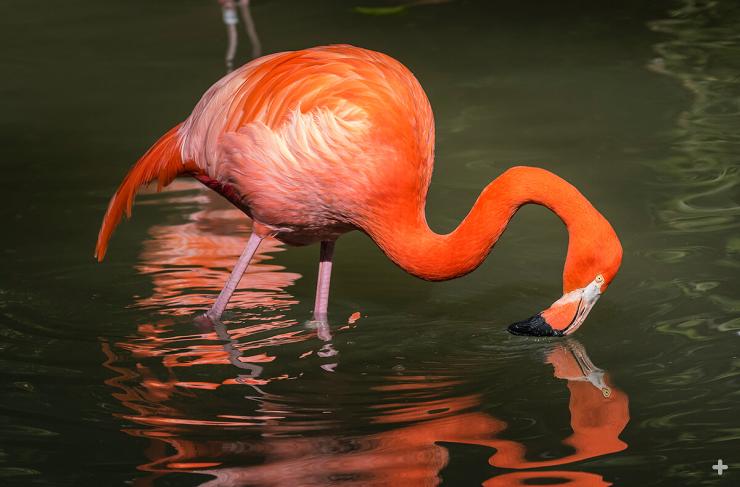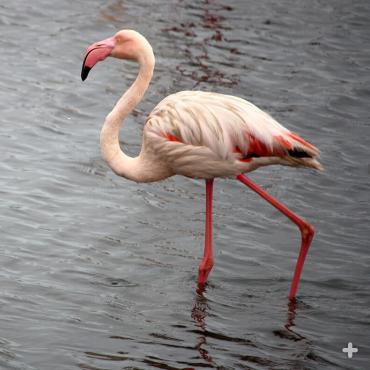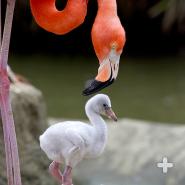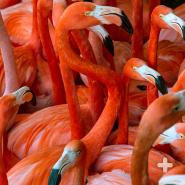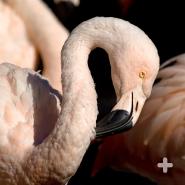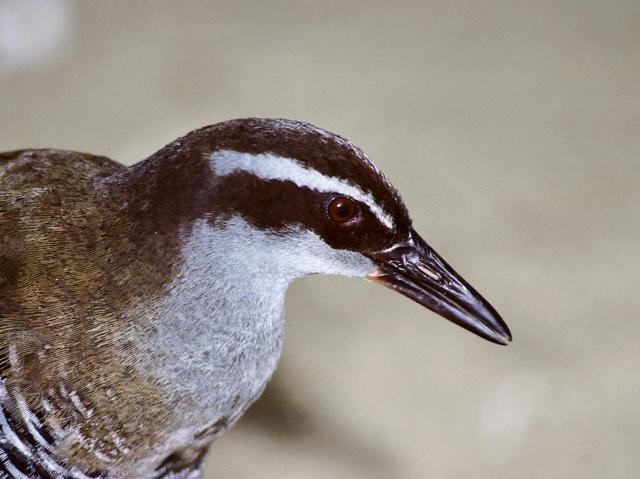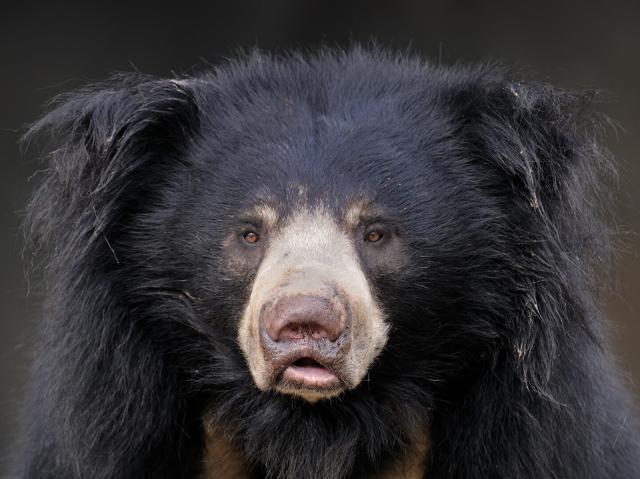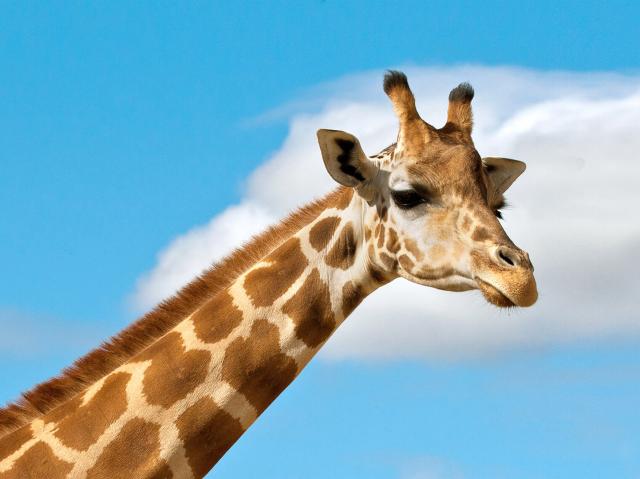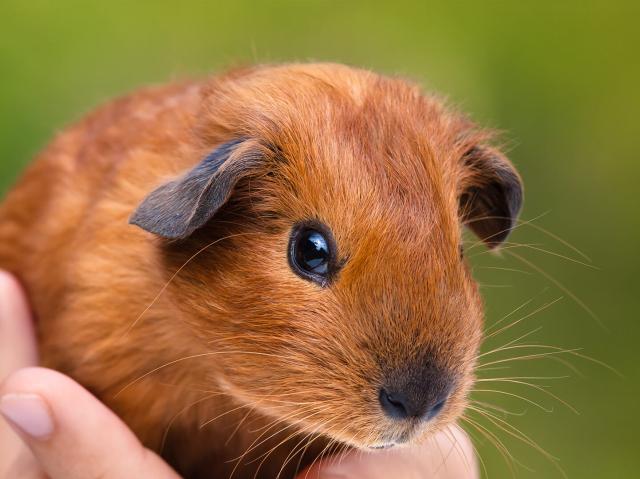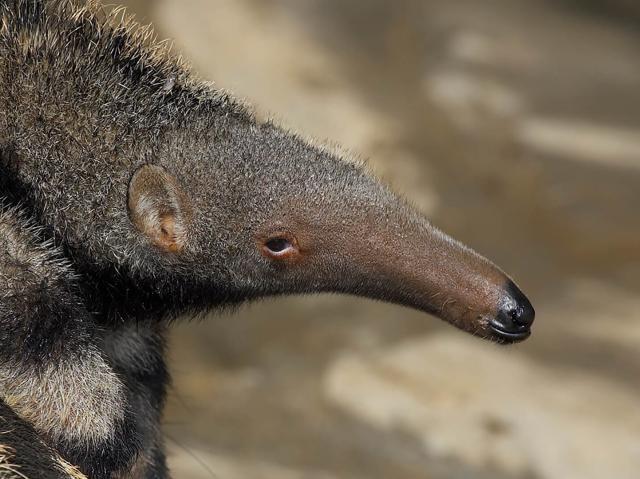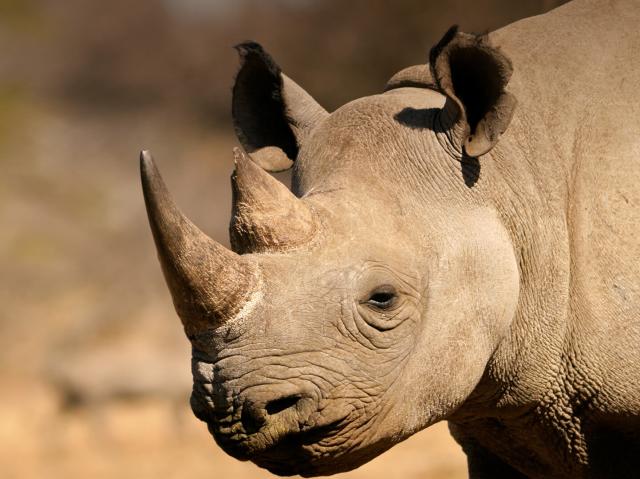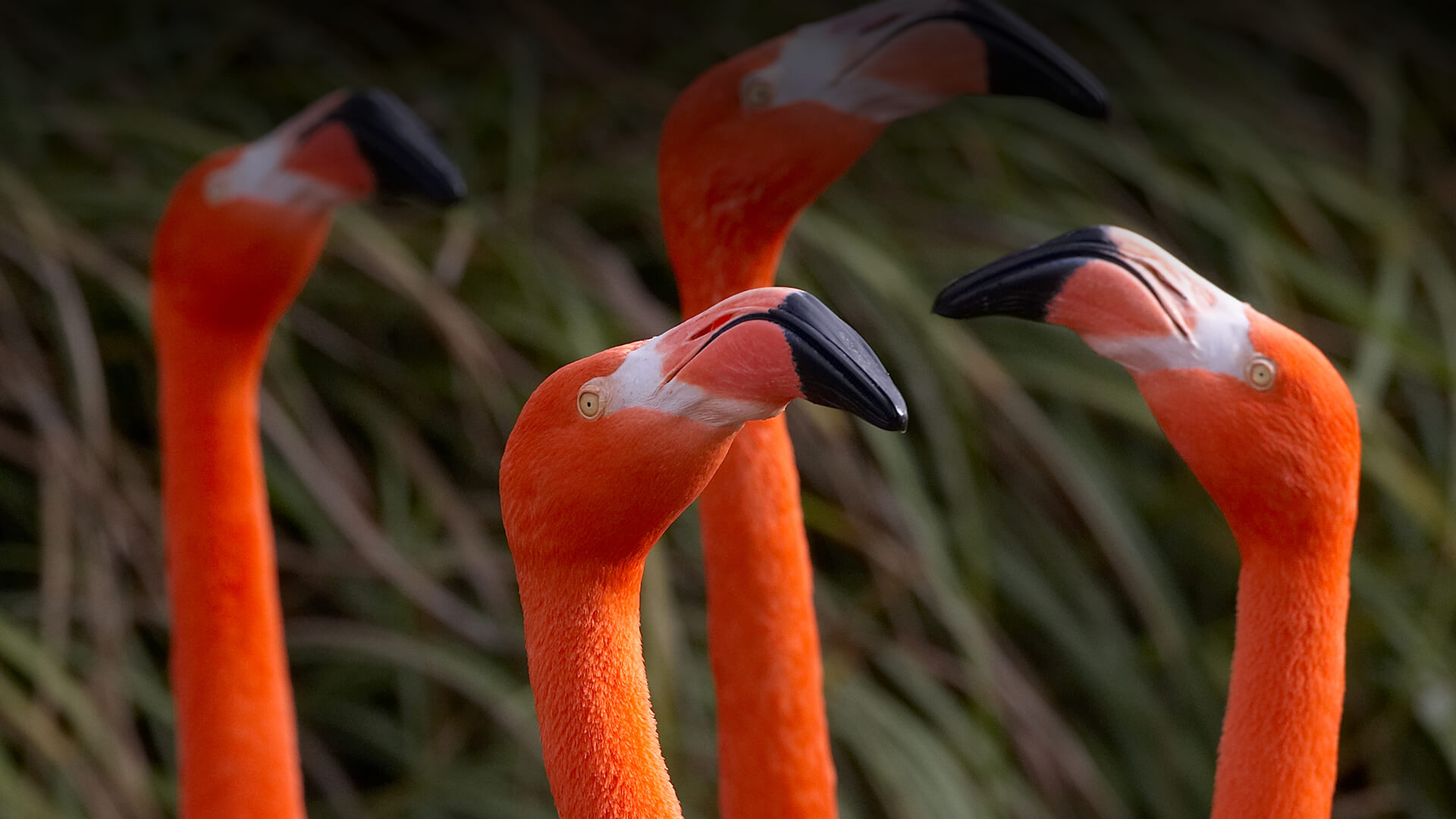
Flamingo

- CLASS: Aves (Birds)
- ORDER: Phoenicopteriformes
- FAMILY: Phoenicopteridae
- GENUS AND SPECIES: Phoenicopterus roseus (greater flamingo), Phoenicopterus chilensis (Chilean flamingo), Phoeniconaias minor (lesser flamingo), Phoenicoparrus andinus (Andean flamingo), Phoenicoparrus jamesi (puna or James’s flamingo), Phoenicopterus ruber (American or Caribbean flamingo)

ABOUT
Think pink—and orange? With their pink and crimson plumage, long legs and necks, and strongly hooked bills, flamingos cannot be mistaken for any other type of bird. These beauties have long fascinated people. An accurate cave painting of a flamingo, found in the south of Spain, dates back to 5,000 B.C. Today, images of flamingos are found in literature (Alice used them as croquet mallets in Through the Looking Glass by Lewis Carroll), and immortalized as plastic lawn ornaments!
The flamingo’s pink or reddish color comes from the rich sources of carotenoid pigments (like the pigments of carrots) in the algae and small crustaceans the birds eat. We eat carotenoids, too, whenever we munch on carrots, beets, and certain other veggies, but not enough to turn us orange! American flamingos, a subspecies of greater flamingo, are the brightest, showing their true colors of red, pink, or orange on their legs, bills, and faces.
In order to fly, flamingos need to run a few paces to gather speed. This speed is not related to the ground but rather to the air, so they usually take off facing into the wind. In flight, flamingos are quite distinctive, with their long necks stretched out in front and the equally long legs trailing behind. Their outstretched wings showcase the pretty black and red (or pink) coloration that, with slight variations, is shared by all flamingo species. When flying, flamingos flap their wings fairly rapidly and almost continuously. And, as with most other flamingo activities, they usually fly together in large flocks. The flamingos follow each other closely, using a variety of formations that help them take advantage of the wind currents.
Flamingos are social birds that live in groups of varying sizes, from a few pairs to sometimes thousands or tens of thousands. Their numbers add to the impressiveness of ritualized flamingo displays; the purpose of these displays is to stimulate hormone production and ensure that as many birds as possible will breed.
Head-flagging: Stretching the neck with head up high and rhythmically turning the head from side to side.
Wing salute: Showing off the contrasting colors with the tail cocked and the neck outstretched.
Twist-preen: The bird twists its neck back and appears to preen its feathers with its bill quickly.
Marching: The large, tightly packed flock walks together as one, before switching direction abruptly.
Flamingos also use vocalizations and these displays to communicate between individuals or alert the group of possible danger. Their vocal repertoire includes growling, low gabbling, and nasal honking.
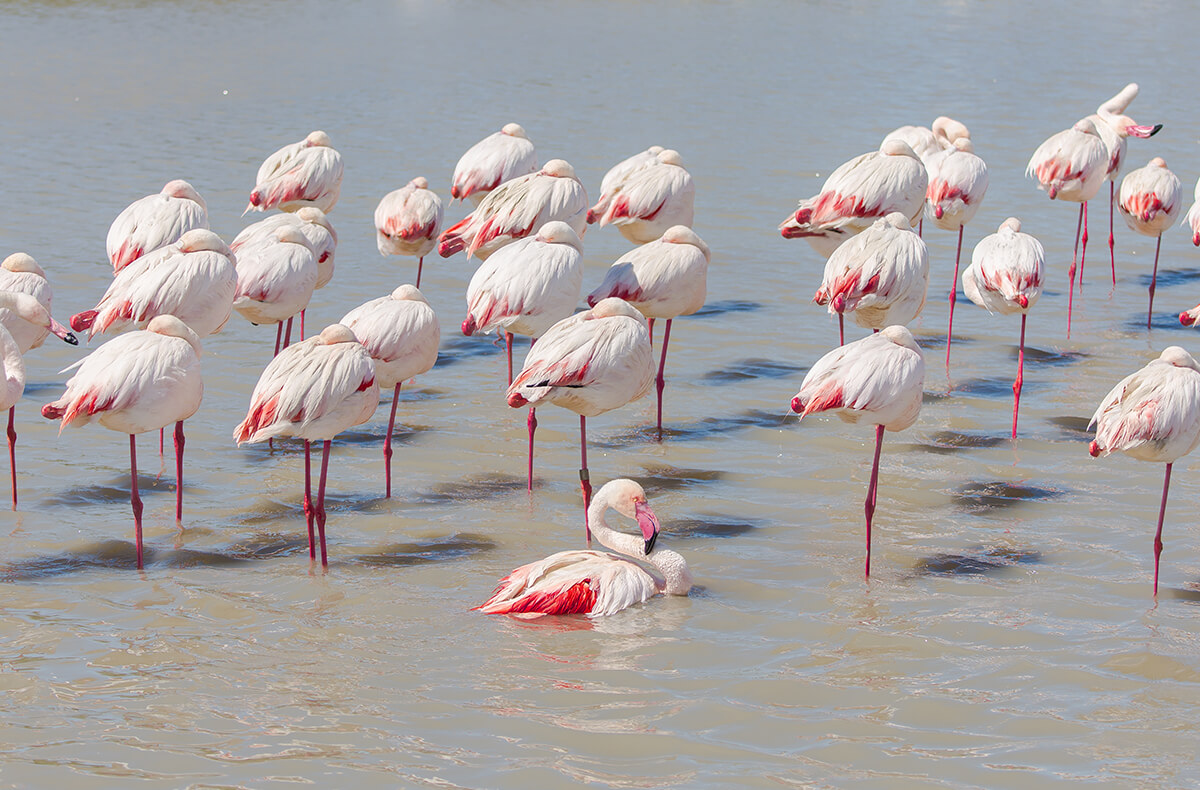
Why do flamingos stand on one leg? Scientists aren’t sure. There is less heat lost through the leg if it is tucked next to the bird’s body; however, this behavior is also seen in hot climates. Another explanation is more mundane: it’s probably a comfortable position for standing. You can develop your own theory about this age-old question on your next visit to the Zoo or Safari Park, where the flamingos are always gorgeous and entertaining.
HABITAT AND DIET
Flamingos live in lagoons or large, shallow lakes. These bodies of water may be quite salty or caustic, too much so for most other animals. In some lakes, their only animal “neighbors” are algae, diatoms, and small crustaceans. That works in the flamingo’s favor, as the birds dine on these small creatures!
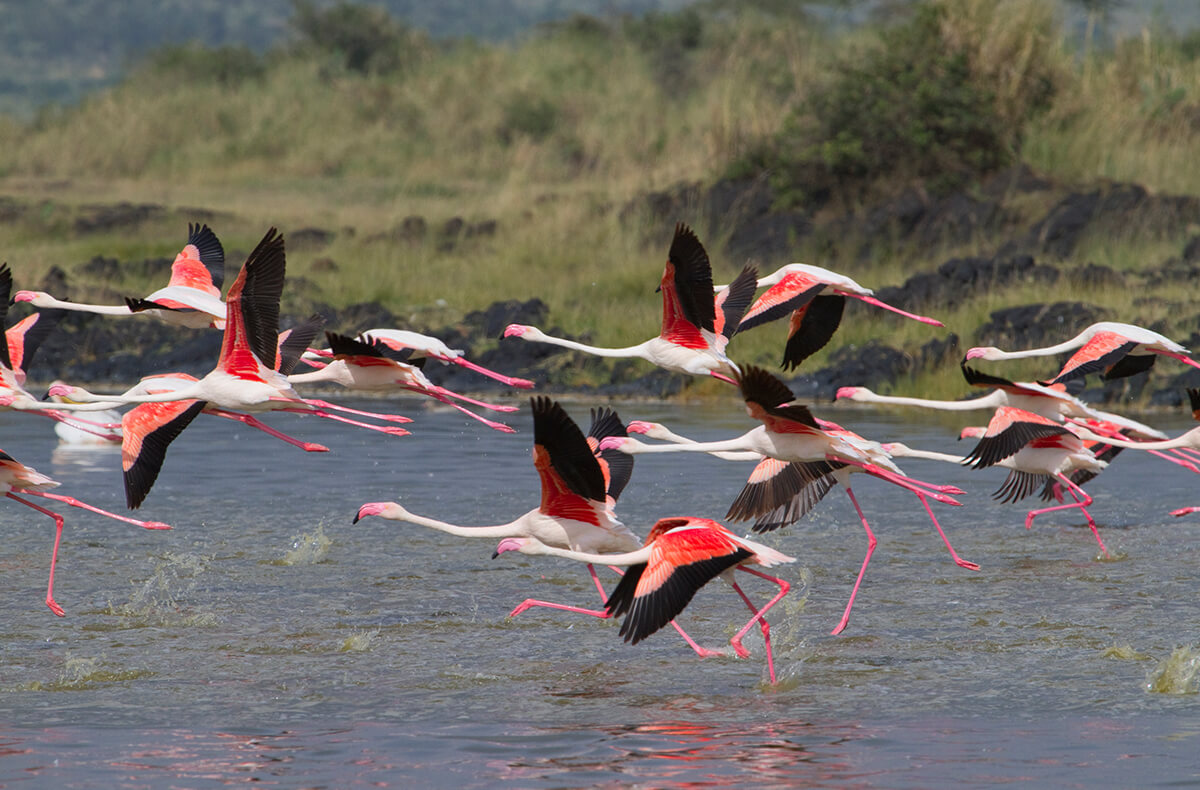
Chilean, Andean, and puna flamingos are found in South America; greater and lesser flamingos live in Africa, with greaters also found in the Middle East; the American or Caribbean flamingo is native to Mexico, the Caribbean, and the northernmost tip of South America.
Long legs let flamingos wade into deeper water than most other birds to look for food. And speaking of food, flamingos also have very distinctive eating habits. The bill is held upside down in the water. Flamingos feed by sucking water and mud in at the front of the bill and then pumping it out again at the sides. Here, briny plates called lamellae act like tiny filters, trapping shrimp and other small water creatures for the flamingo to eat.
The smaller puna, Andean, and lesser flamingos have deeper bills and stiff lamellae. This helps them filter very fine particles, such as algae, through their bill and keep bigger particles out. Greater and Chilean flamingos are larger and feed mostly on invertebrates such as brine flies, shrimps, and mollusks. They get these food items from the bottom mud by wading in shallow water. Sometimes they swim to get their food and sometimes by “upending” (tail feathers in the air, head underwater) like ducks.
At the San Diego Zoo and the San Diego Zoo Safari Park, the flamingos are fed a special pellet diet that is made for zoo flamingos. This food has all the nutrients the flamingos need and a pigment that helps keep them “in the pink.” To allow the flamingos to eat in their normal way (taking in water and then pumping it back out), a water source just for feeding is near their food so they can get a “beakful” of water and then food—just like they would in the wild.
FAMILY LIFE
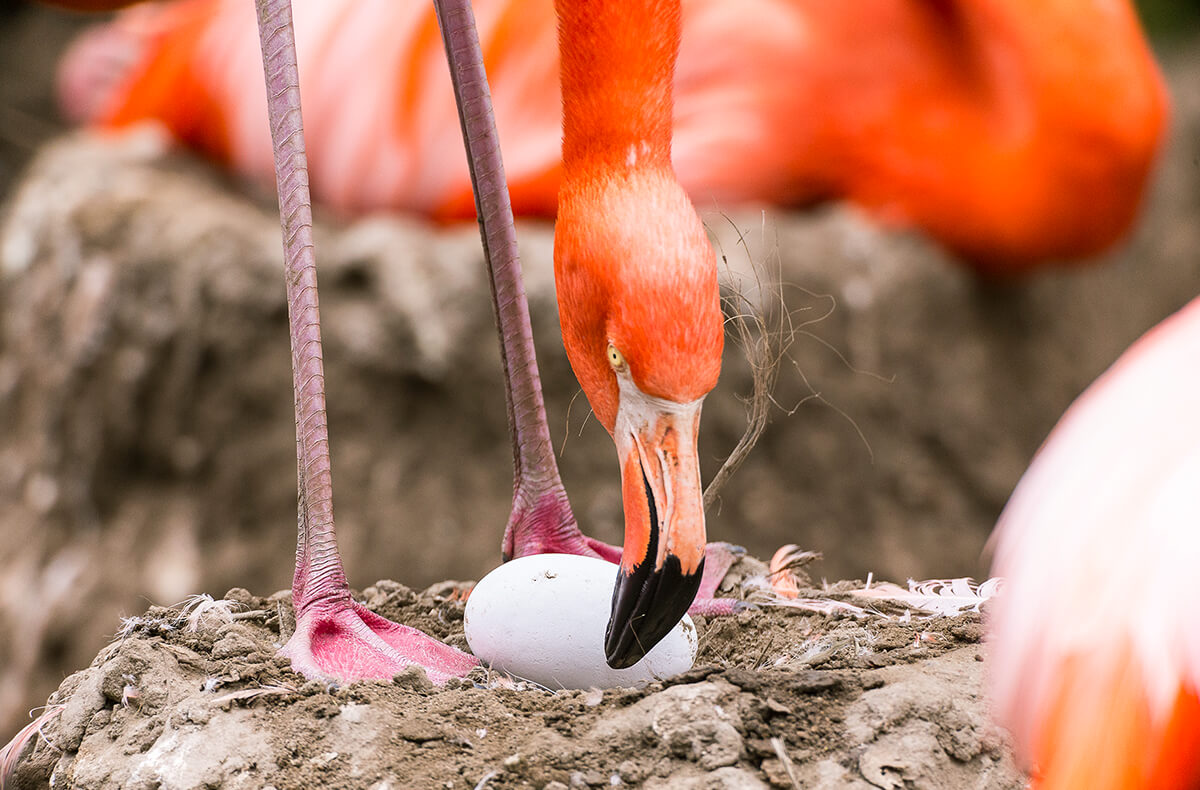
A flamingo nest is not fancy, just a mound of mud, maybe 12 to 24 inches (30 to 60 centimeters) high. The nest needs to be high enough to protect the egg from flooding and from the occasional intense heat at ground level. Both the male and female build the nest by using their bills to pull mud toward their feet. The top of the mound is concave so that any egg laid does not fall off. Neighboring nests are built very close, and bickering between nest mound occupants is common.
Prior to breeding, the male is selected by the female, and he then closely follows behind her in shallow water. The individual courtship rituals tend to be subtle and inconspicuous to humans. The pair tends to stay together as long as there is reproductive success. If not, then the female may choose a new mate.

Flamingos lay one large, chalky white egg in a mud nest build like a sand castle by the parents. A parent sits on the mound, reaches over, picks up mud and dribbles it onto the nest, which can reach 2 feet (0.6 meters) in height and is usually surrounded by a trench as further protection from rising water. At hatching, a flamingo chick has gray down feathers and is the size of a tennis ball. It also has a straight, pink bill and swollen pink legs, both of which turn black within a week.
After hatching, the chick stays on the nest mound for 5 to 12 days. During this time, the chick is fed a type of “milk” called crop milk that comes from the parents’ upper digestive tract. (Flamingos share this trait with pigeons, doves, and certain penguins.) Both males and females can feed the chick this way, and even flamingos that are not the parents can act as foster-feeders. The begging calls the hungry chick makes are believed to stimulate the secretion of the milk. As the parents feed their chicks the crop milk, they are drained of their color—so much so that their plumage turns a pale pink or white! The parents gain this color back eventually as the chicks become independent and eat on their own.
By the time a chick leaves the nest, it can already walk and swim quite well. Chicks flock together in large groups called crèches, looked after by a few adults, possibly birds that have lost their own young. Parents visit the crèche and continue to feed their chick with the milky secretion. But how do they find their offspring in such a large and noisy group? Chicks and their parents recognize one another through their distinctive calls! Adult flamingos have few natural predators, as they tend to live in inhospitable places where the lagoons are pretty bare of vegetation, so few other birds or animals come there. But flamingo chicks are sometimes preyed upon by eagle species.
AT THE ZOO
Guests are instantly drawn to our flamingo flock as they enter the San Diego Zoo. And who wouldn’t be? With their flamboyant color and amusing behaviors, flamingos have been on hand to welcome Zoo guests since 1932, about 10 years after the Zoo grounds opened to visitors. They are our unofficial ambassadors!
CONSERVATION
Over time, people have used flamingos for food and medicine. Currently, no flamingo species is endangered, although the puna or James’s flamingo was thought to be extinct in 1924; it was rediscovered in 1957.
But as with many wild species, the threat of habitat loss due to road construction and housing development is causing some populations to be threatened. In 1989, about 100 Caribbean flamingos died in Mexico’s Yucatan Peninsula from lead poisoning, due to the ingestion of lead shot. Lead bullets are now prohibited in that area.
The Andean flamingo is considered the rarest of the flamingo species. It lives high in the mountains of Chile, Peru, Bolivia, and Argentina. People have been collecting the flamingos’ eggs and expanding into their habitat with farms, road construction, and urban development. Chile has now established a national flamingo reserve around one of the lakes used by the birds for breeding colonies and is taking steps to protect other lakes for the flamingos.
The Flamingo Specialist Group was created in 1978 to study, monitor, and help conserve the world’s flamingo populations. Working with the International Union for Conservation of Nature, the group monitors and surveys wild flamingos and develops action plans for species that may be threatened.
LIFE SPAN
20 to 30 years in the wild; up to 50 years in zoos
YOUNG
Number of eggs laid: Usually 1
Length of egg: 2 to 3.5 inches (78 to 90 millimeters)
Weight of egg: 4 to t.9 ounces (115 to 140 grams)
Incubation period: 27 to 31 days
Weight at hatch: 2.5 to 3.2 ounces
Age of maturity: 3 to 5 years
SIZE
Height: Tallest - greater flamingo, 3.9 to 4.7 feet (120 to 145 centimeters); shortest - lesser flamingo, 2.6 to 2.9 feet (80 to 90 centimeters); males of all species are larger than females
Weight: Heaviest - greater flamingo, 4.6 to 9 pounds (2.1 to 4.1 kilograms); lightest - lesser flamingo, 3.3 to 4.4 pounds (1.5 to 2 kilograms)
Wingspan: 3.3 to 5 feet (1 to 1.6 meters)
FUN FACTS
Flamingos have good hearing but little or no sense of smell.
Once shed, flamingo feathers quickly lose their color.
The Andean flamingo is the only flamingo species with yellow legs.
Flamingos like company! In East Africa, more than one million lesser flamingos may gather together, forming the largest flock known among birds today.
The San Diego Zoo and the San Diego Zoo Safari Park are among only a handful of zoos in the world to raise offspring from four of the six flamingo species. Together, we have successfully hatched more than 450 chicks, so far.
The ancient Egyptians used the silhouette of the flamingo as the hieroglyphic for the color red, and it also represented the reincarnation of Ra, the Sun God.
Flamingos, like pigeons, feed their chicks a milky fluid from their upper digestive tract. Its nutritional value is similar to the milk mammals produce!


